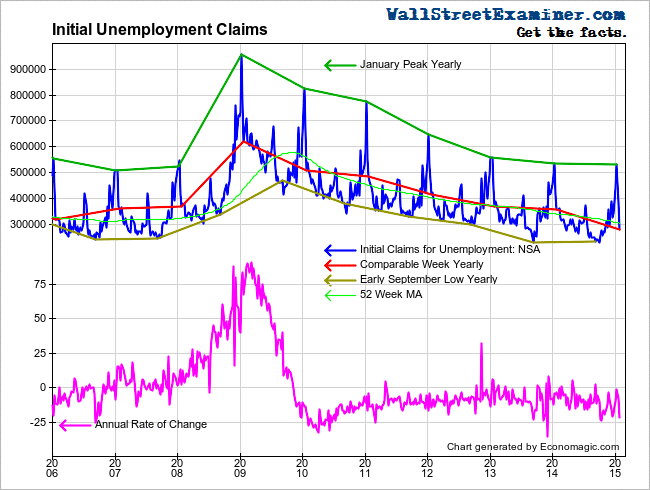Courtesy of Lee Adler of the Wall Street Examiner
The headline, fictional, seasonally adjusted (SA) number of initial unemployment claims for last week came in at 265,000, which blew out the Wall Street conomist crowd consensus guess of 301,000. The pundits had shaved 1,000 off their guess after missing on the low side last week. My, my! Such pessimists!
But my interest is not in the silly expectations game of pin the tail on the number. My interest is in the actual, unmanipulated data. Analyzing that is the only way to be sure that you are seeing what’s really going on.
The Department of Labor prominently reports the actual unadjusted data clearly and illustrates it in comparison with the previous year. As it does with virtually all government economic data releases, the mainstream financial media crowd chooses to ignore reality by not reporting the actual number. In the case of this report, the DoL also reports exactly how messy the seasonally adjusted data is by reporting what the seasonal adjustment had forecast based on the arbitrary mathematical calculation of what’s normal.
According to the Department of Labor the actual, unmanipulated numbers were as follows. “The advance number of actual initial claims under state programs, unadjusted, totaled 280,237 in the week ending January 24, a decrease of 102,358 (or -26.8 percent) from the previous week. The seasonal factors had expected a decrease of 57,297 (or -15.0 percent) from the previous week. There were 357,806 initial claims in the comparable week
in 2014.”
The actual week to week change last week was a drop of 102,000 (rounded). This is a greater decline than the 10 year average decrease for that week, which was a decrease of 88,000 (rounded). This year’s drop was also larger than the comparable weeks of 2014 and 2013 which fell by 58,000 and 68,000 respectively.
Actual first time claims were 21.7% lower than the same week a year ago. This is at the extreme of the normal range, which since 2010 years has mostly fluctuated between -5% and -15%. There have only been a few weeks where the year to year decline was more than 20%. But that’s the 4th instance since last September.
In the past 5 months, businesses have been unusually reluctant to cut workers. In fact, these are all time record lows in terms of the number of claims per million workers. Is that a sign of a healthy, growing economy, or a bubble economy stretched to the limit? The last two times these numbers were nearly as strong were at the tops of the housing bubble and the internet/tech bubble. The current readings come on the heels of the long running US oil/gas bubble, which has recently collapsed.
I track the daily real time Federal Withholding Tax data in the Wall Street Examiner Professional Edition. It too has been very strong over the past couple of weeks. The growth rate of withholding taxes is now running at an annual rate of gain of about 3.75% in real terms, adjusted for the trend rate of increase in workers’ weekly incomes.
While we have been teased with signs of change in the claims data from time to time, the trend is still in force. Only if we start to see the numbers coming in above the comparable week for the past year for a few weeks would it be a sign of material change in trend, and a possible excuse for the Fed to bring back the Ghost of QE Past. The current data will encourage the Fed start the smoke and mirrors game of pretending to raise interest rates.
I have been reporting that claims were at record bubble levels since September 2013. At the tops of the last two bubbles in 1999-2000 and in 2006-07 claims persisted at record low levels for a year before the economy plunged. The economic foundations were already beginning to crumble by the time the first anniversary of record readings rolled around. In other words, employers were either slow to get the message or slow to act. In the current market, the claims numbers have stayed near or at record lows from September 2013 until now. The extreme condition has now persisted for 17 months. It seems that this is either the healthiest job market ever, or the bubble to end all bubbles.
I have inverted the scale on the chart below to show the correlation with stock prices. The rate of improvement clearly slowed in 2013 and 2014 concurrent with the massive surge in Fed QE. The rate of improvement in claims was much stronger in 2012 when the Fed was not doing QE. And it appears that once again when the Fed has stopped shoveling cash at financial engineers and speculators, the jobs numbers perk up.
While the direction of the stock market is positively correlated with QE, since 2012, improvement in the job market has been negatively correlated. This is clear evidence that the conomists and media pundits are wrong. QE did NOT boost the US recovery. It suppressed it while enabling and encouraging their financial engineers ran their skimming scams.





